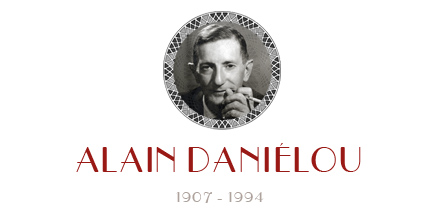EDITO
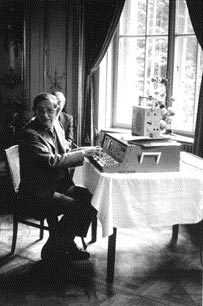
Photo: Alain Daniélou présentant à Berlin en 1978, le S52 prototype du Semantic construit par André Kudelski et Claude Cellier.
© Dominique Nabokov.
It is with an enthusiastic goose quill that I am writing to you on this Summer Solstice 2006…
Music,
The culmination of a project that began in 1936 – 70 years ago! -, on which I have been working for the past 14 years, is in itself something to bring joyful satisfaction to our little Centre. Indeed, I have just returned from Geneva, where I received the result of the commission given to the composer Igor Wakhévitch: a work for the Semantic created by Christian Braut and Michel Geiss according to the theories on microintervals established by Alain Daniélou, an instrument that has been mentioned many times in these newsletters and is also described on our site.
The composer worked with the sole existing prototype and his task was not an easy one. The outcome is a magnificent work, full of matter, varied and inspired, giving us an idea of the Semantic’s astonishing potential. We hope to put some extracts on the site very soon. I renew my thanks and admiration to Igor Wakhévitch for this new work, entitled “Anata-Anahata”.
This composition is a good omen for the events and publications envisaged next year to celebrate the centenary of Alain Daniélou’s birth.
While the Semantic is on its way to new adventures at the AEH, the Atelier d’Exploration Harmonique du Thoronet, directed by M. Jacques Dudon, the Italian composer Luigi Esposito has just announced the completion of 38 variations for the Semantic. We hope to be able to give you further details about this work in one of the next newsletters.
Events,
The exhibition “Lumières de l’Inde”, having remained for several months during the winter at the Maison de l’Inde on Place Saint Sulpice in Paris, has now moved to Belgium.
Our thanks go to Madame Toussaint, manageress of the bookstore Chapître XII in Brussels, for her kind welcome and the beautiful Indian decorations she provided for the opening night, as well as to M. Gérard, M. Matzneff and Mlle Ramaekers for their friendly support during the launch. From Brussels, the exhibition moves on at once to the major bookstore “Molière” at Charleroi, where it is enjoying considerable success and will stay until October.
Two other exhibitions are on the way: the first is of photos of musical life in India by Alain Daniélou, taken between 1935/1955. Simon Hamelin is undertaking its preparation and we hope to find a publisher, so as to publish it like “L’Inde Traditionnelle”, published by Fayard, which serves as a catalogue to the exhibition “Lumières de l’Inde”. The second – an exhibition of over one hundred drawings by Alain Daniélou, made during his trip round the world in 1936 – is now ready.
Publications,
We have also just received the English edition of one of the “Mleccha’s Notebooks” – India, A Civilization of Differences, The Ancient Tradition of Universal Tolerance, published by Alain Daniélou’s chief publisher in the United States, Inner Traditions International (Rochester, June 2005), and the Spanish edition El Shivaismo y la Tradicion Primordial (Kairos Editions, Barcelona, May 2006), achieved thanks to the French publisher and the director of the series. The cover illustration is a magnificent photo of the young photographer A. M. Ganesh; the translation is by Vicente Merlo.
The first phase of the “Mleccha’s Notebooks” published by Editions Kailash has closed very satisfactorily, with five works published in French . Five translation were done : one in Tamil, one in Spanish and three in English (of which one at Benares and the others in the U.S., the last – with the title Shiva and the Primordial Tradition – From the Tantras to the Science of Dreams – currently with the printers, all three translated by Ken Hurry. Further texts by Alain Daniélou will be published in the near future, particularly those on music in the various countries he visited while creating the Unesco record series of traditional music.
Seminars,
Professor Lakshmi Subramaniam (Centre for Studies in Social Sciences, Calcutta), a historian specialising in the social history of music, intends to hold a seminar in India in 2007 on Daniélou’s work to protect and diffuse the art music of the East, and particularly of India. Indian musical circles are very aware of the great importance of Daniélou’s work in this field, for which he was made a member of the Sangeet Natak Akademi, similar to the Académie des Beaux-Arts of the Institut de France. Madame Subramaniam envisages several exhibitions and publications within the framework of this Indian seminar.
I greatly appreciate this initiative, which will allow the younger generations to rediscover Shiva Sharan in his adoptive land.
In closing this note, I wish to announce that we foresee a complete overhaul of the site in the autumn, and that further translations in Italian are being prepared for the end of the year.
Happy Solstice!
Jacques. E. Cloarec
ACTUALITÉS
Les Cahiers du Mleccha – Vol V 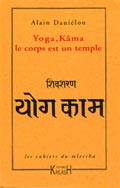 – Yoga, Kâma le corps est un temple
– Yoga, Kâma le corps est un temple
Kailash éditions, Paris, 2006.
Alain Daniélou’s studies on Yoga and the traditions of the Yoga Upanishad have long been unavailable: this definitive collection now completes Yoga, Mastering the secrets of Matter and the Universe.
His texts on eroticism – one given at a conference at the Sorbonne in 1968 – also complete a subject that runs throughout his work and shows his great independence of spirit. This is especially true of the pages dealing with homosexuality, originally written for specialised magazines, as well as the final long unpublished paper with its tone of personal meditation.
“The body is a tabernacle”, wrote Daniélou, on the subject of eroticism. “The body is a tool”, he adds, in writing about Yoga. “The body is our only instrument”, he says in the also unpublished interview that opens this collection. Yoga and Kāma together thus constitute the subject of the fifth Mleccha’s Exercise Book.
J.L Gabin.
– India A Civilization of Differences
Inner Traditions, Rochester, Vermont, 2005
Translated from the French by Kenneth Hurry
In India : A Civilization of Differences Alain Daniélou builds a bold and cogent defense of the Hindu caste system, viewing it not as racist inequality but as a natural ordering of diversity. Instead of being a hierarchy with some who are privileged and others who are despised, it is an organizing principle of a society wherein differences are embraced rather than ignored.
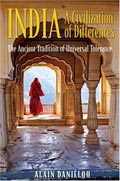 Daniélou argues the point that negative stereotypes about the inequality of Indian society were invented by Westerners to justify the goals of colonialism.
Daniélou argues the point that negative stereotypes about the inequality of Indian society were invented by Westerners to justify the goals of colonialism.
In classical India, social ethics are based on each individual’s functional role in society. These ethics vary according to caste in order to maximize the individual’s effectiveness in the social context. In the caste system it is up to the individual to achieve perfection in the state to which he or she has been born, since to a certain extent that state also forms part of a person’s nature. All people must accomplish their individual spiritual destinies while as members of a particular social group, ensuring the continuity of the group and collaborating in creating a favourable framework for all human life – thereby fulfilling the group’s collective destiny. The notion of transmigration provides an equalizing effect on this prescribed system in that today’s prince may be reborn as a woodcutter and the Brahman as a shoemaker.
Daniélou thoroughly explores this seldom-heard side of the caste debate and argues effectively in its favor. This rare collection of the late author’s writings contains several never-before-published articles and offers an indepth look at the structure of Indian society before and after Western colonialism.
– Histoire de l’Inde
 The club edition of Alain Daniélou’s book “Histoire de l’Inde” was published in the magazine “Club Histoire” (by GLM) for the month of February 2006.
The club edition of Alain Daniélou’s book “Histoire de l’Inde” was published in the magazine “Club Histoire” (by GLM) for the month of February 2006.
REVUE DE PRESSE
– SACRED MUSIC: ITS ORIGINS, POWERS AND FUTURE by Alain Daniélou.
Pub: Indica Books, D 40/18 Godowlia,Varanasi, 221 001, 2003, Rs 250, pp. 224. – indicabooks@satyam. net. in
Alain Daniélou (1907-1994) whose Hindu name was Shiva Sharan (‘protected by Shiva’) lived in India for many years. He was a Sanskrit scholar and also fluent in Hindi and Tamil. He wrote many books about India, the best known of which is probably the classic The Myths and Gods of India (New York 1991), first published as Hindu Polytheism in 1964. He was also a musicologist and a proficient veena player. Early on, the poet Tagore appointed him Director of Music at Shantiniketan. He was passionately dedicated to research into Indian classical music and he played a major part in the growth of Western interest in it.
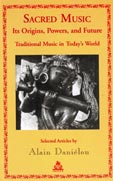 He was such a brilliant, erudite polymath (a painter as well) that any new publication of his work is very much to be welcomed. This book, being a collection of articles dating from 1950 to 1974, inevitably lacks some coherence but compensates by diversity of interest. Fifteen of the twenty-four articles are previously unpublished.
He was such a brilliant, erudite polymath (a painter as well) that any new publication of his work is very much to be welcomed. This book, being a collection of articles dating from 1950 to 1974, inevitably lacks some coherence but compensates by diversity of interest. Fifteen of the twenty-four articles are previously unpublished.
Perhaps the most interesting chapter of the book is entitled Modal Music and Harmonic Music. A later chapter, Music, an International Language? continues this absorbing theme. The author identifies three kinds of music: harmonic, modal and cyclic. Cyclic music is Chinese and outside his scope.
Western music is fundamentally harmonic, being structured by chord progressions; only about two dozen chords are used. M. Daniélou claims that it has come into direct conflict with Indian music. Indian classical music, of very ancient origin, is modal; it establishes a fixed root note (the tonic) and the music is based on its intervals or, strictly speaking, its sound ratios. There are also certain other secondary tones known as dominant notes.
A mode is called a raga (‘state of mind) which is defined by the tonic plus a set of notes, usually varying from five to twelve, which form its scale or gamut. Indian music is essentially meditative.
According to the author modal music is more flexible, complex and powerful than harmonic music which it might well be; I am not qualified to judge. He feels called upon to proclaim it to be superior as he considers it to be under attack by ‘harmonic aggression’, an aspect of a still existing Western cultural imperialism. ‘To harmonise a raga is to destroy it.’ But who wants to do so?
Is it really fruitful to compare incompatible forms of music in such a polemical way? Surely both have their virtues. Nowadays Indian classical music is well known and loved in the West if, not surprisingly, not so well understood. Whoever considers it to be inferior cannot be taken seriously. Also, where harmonization is concerned one should strongly distinguish between Indian classical and popular music. I cannot possibly say whether Indian popular taste has changed,
There is much discussion of intervals throughout the book and A Daniélou favours an octave of fifty-two intervals. An electronic musical instrument called the Semantic has been produced tuned according to his theory, which I would love to hear played.
The author is extremely critical of what is in his view the limiting compromise of so-called ‘equal temperament’ used in Western music, going so far as to say that it leads to a severe loss of emotive power, let alone any possible magical effects. He makes a persuasive case but try telling that to a Wagnerian!
He also feels that Western classical music has become too dry, abstract and intellectual. This is a damaging opinion that I strongly disagree with.
I found this an original, stimulating and provocative book spoilt slightly by a somewhat defensive, dogmatic tone. It is a fascinating read, full of compelling facts and unique insights that are more suited to the specialist, but is well worth reading even by someone with as limited a technical knowledge of music as mine and who must admit to having forgotten the meaning of the rather Miltonic word ‘lucubration’ which M. Daniélou likes.
Patrick Roberts, Mountain Path, vol. 43, N° 2, April June 2006, Tiruvannamalai, p. 104-105.
– « Daniélou le noble voyageur »
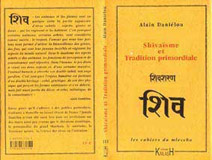 Far from being just a historian of religions and specialist in Hinduism, Alain Daniélou was what the German romantic school – and before them the fidèles d’Amour, termed a “noble traveller”. For him, traditional India was a spiritual homeland. Besides all analysis and explanation, in this case particularly well supported by the best standards of scholarship, his progress highlights an implication, particularly in the domain of music. Thus, the musicologist was at the same time a musician, just as the scholarly exegetist of mythologies added an inner experience to his knowledge.Thus, Jean-Louis Gabin writes in his preface to Shivaïsme et tradition primordiale, “Such an adhesion to the object of research is almost unknown in the university approach, set on the “critical distance.” His adherence can best be understood in the artistic domain, in considering Gauguin and his metaphysical Tahitian universe, which the colonization and the missions of his own time were busy destroying. Daniélou’s approach relates first and foremost to the traditional quest, which aims at identifying the seeker with the object of his search, or—if one prefers— the initiate with knowledge”. Segalen, in his Immémoriaux, Louis Massignon, in his Passion d’Al-Hallâj, provide further examples of creative hermeneutics, this particular felicitous and rare alliance between scientific rigour and poetic accuracy.
Far from being just a historian of religions and specialist in Hinduism, Alain Daniélou was what the German romantic school – and before them the fidèles d’Amour, termed a “noble traveller”. For him, traditional India was a spiritual homeland. Besides all analysis and explanation, in this case particularly well supported by the best standards of scholarship, his progress highlights an implication, particularly in the domain of music. Thus, the musicologist was at the same time a musician, just as the scholarly exegetist of mythologies added an inner experience to his knowledge.Thus, Jean-Louis Gabin writes in his preface to Shivaïsme et tradition primordiale, “Such an adhesion to the object of research is almost unknown in the university approach, set on the “critical distance.” His adherence can best be understood in the artistic domain, in considering Gauguin and his metaphysical Tahitian universe, which the colonization and the missions of his own time were busy destroying. Daniélou’s approach relates first and foremost to the traditional quest, which aims at identifying the seeker with the object of his search, or—if one prefers— the initiate with knowledge”. Segalen, in his Immémoriaux, Louis Massignon, in his Passion d’Al-Hallâj, provide further examples of creative hermeneutics, this particular felicitous and rare alliance between scientific rigour and poetic accuracy.
What about the “subtle structures of the human being”? What are the modalities of the One and the multiple? What are the basic relations between the apparent and the real? In actual fact, polytheism in no way excludes a meditation on the One, or, more precisely, on “non-duality”, since the metaphysics of the One is always threatened by what Henri Corbin termed the “metaphysical idolatry of the One”, itself dualist inasmuch as it sets the
One against the multiple. So, “what remains when the spirit realises that the concepts of living being and divine being are pure illusions and that perceptible appearances have no reality at all is know as the “non-dual immensity” (Advaya-Tāraka Upanishad).
The various texts brought together in this collection, “Shaivite Cosmology and Polytheism”, “The Symbolism of the Linga”, “Music Mankind and Gods”, “The Nature of Beauty”, amongst others, answer such questions while posing others that directly concern the origin of our thought and our civilisations. Thus we learn that metaphysics takes less from dogma, from congealed scholasticism, than from music. “Music has seven letters, writing has twenty-five notes”, wrote Joseph Joubert, inviting thought to range through infinite variations and by way of “response” to the Vishnu Purana: “It a movement of the air, itself undifferentiated, that produces the various notes by means of the different holes in the flute. Similarly, the various states of being appear to exist starting from a supreme and undifferentiated Self.” Alain Daniélou’s work thus provides us with a panoramic view of the destiny of these gods, who dance, love and fight in apparent disorder, of which, however, each one “presides over the function of an aspect of the Universe”.
Review from the magazine “Eléments pour la civilisation européenne”, Paris, Autumn 2005.
On Alain Daniélou’s work: Shivaïsme et tradition primordiale, éditions Kailash (to be published shortly in the U.S. by Inner
Traditions with the title Shiva and the Primordial Tradition – From the Tantras to the Science of Dreams, translated by Ken Hurry).
EXTRAIT
Extraits de ce catalogue : Les Contes du Labyrinthe
Éditions du Rocher : 1990.
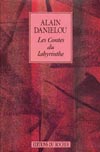 This title comprises five tales, placed in the Lazio region, south of Rome. The tutelary image of Daniélou’s work, the labyrinth is also the name of the area he chose as his home on returning to Europe.
This title comprises five tales, placed in the Lazio region, south of Rome. The tutelary image of Daniélou’s work, the labyrinth is also the name of the area he chose as his home on returning to Europe.
These short stories are largely autobiographical, particularly the tale of Tages and the two friends Gwyn and Arno, harking back to Alain Daniélou’s early days in the Roman countryside, its discreet paganism and closeness to nature not unlike India, his country of choice for thirty years.
“The Sun’s Gift” (Le don du soleil) makes this connexion explicit. Daniélou’s protagonist is a young Roman, Ludovico, who, fascinated by the atmosphere of the Sun Temple during a trip to India, learns that Shivaism, the cult practiced there, had its match in the West in Mithraism. Catholicism, although initially very close to Mithraism, came to oppose its values and banned the Mithraic cult. While Catholicism ostentatiously triumphs throughout this area, the fiefdom of the pope, paganism animates nature, the nymphaea and mithraeums lost beneath the foundations of its churches.
It is consequently not astonishing when events occur that are incomprehensible for westerners saturated with rationalism or Catholicism, like the collapse of a dam, persons disappearing only to reappear in a wholly different context, having forgotten their earlier adventure.
Having lost immemorial knowledge, convinced that modernity holds the key to happiness and desirous of imposing it on the entire world, people are surprised when these despised archaic societies win the contest against their imperialistic and ill-omened projects by mysterious means beyond their understanding.
In his light and didactic style, Alain Daniélou once more tackles the key themes of his work: warning against a levelling and destructive colonialism, and recommending the harmonious knowledge of ancient civilisations, in which ethics and aesthetics are never separate.
In this book, Alain Daniélou discovers for us an enchanted world in which the supernatural is an everyday event. Anne Prunet, Marie-Laure Bruker.
Anne Prunet, Marie-Laure Bruker.
RENCONTRES
– My Debt to Alain Daniélou
by Christopher Gérard,
Brussels, May 2006
“Je n’ai jamais eu un corps et une âme séparés”
Alain Daniélou, Le Chemin du Labyrinthe, 1981.
Habent sua fata libelli. Books have their own destiny. Thus it was that, on August 4th 1984, browsing at a Brussels bookstore, I discovered The Way to the Labyrinth, the iconoclastic memoirs of Alain Daniélou (1). Read at one sitting and producing an abundance of annotations, this book in some way changed my life, first and foremost because it stimulated me to persevere in my singularity. At once, I recognised in Daniélou a kind of distant master, whose work has never left me since then. Hergé was right when he wrote: “It’s a zigzag itinerary you’ve followed (or isn’t it rather the itinerary that has followed you?), with another itinerary implicit in it, a straighter one, that of spiritual adventure” (2).
The student of ancient languages could not avoid being fascinated by this “noble traveller” who had discovered Afghanistan in 1932, danced with Balanchine between two interviews with Cocteau, frequented (a little later on) Stravinsky and Corbin, Béjart and Menuhin! What a contrast between my sage studies and the whimsical tribulations of Alain Daniélou, alias Shiva Sharan! What a difference between his Brahmans and my homines academici!
A few months later, in March 1985, I discovered Le Défi, my first book by Gabriel Matzneff, a friend of Daniélou’s, as also of Hergé, Cioran and Montherlant. This was reading matter for a budding philologist! This was to be his mental homeland, light years away from what was fashionable. While most of my co-disciples read nothing that wasn’t on their “syllabus” (a Belgian term for a “duplicated course”), while the intellectuals blundered through their now repudiated sacred scriptures, I was learning about singularity from my awakeners: Daniélou, Matzneff, and a few other freethinkers of the time.
Since then, I have got to know Alain Daniélou’s work better, through reading, as also thanks to conversations with his pupil and friend, Jacques Cloarec. In this way I came to understand the extent to which this “marginal who succeeded” (B. Pivot) had attained a knowledge that was not at all banally academic, limited to a maniacal accumulation of references, but a caring knowledge, a harmonious mixture of appetence and competence. A love of wisdom, a philo-sophy in the Greek sense. A wild rather than an progammed erudition. It was in view of this that J. Cloarec thought to call one of his presentations “Wisdom and Passion”, since indeed his master teaches us both one and the other (3). In this sense, Daniélou was an exemplary pagan, since the pagan adheres instead of preaching.
This profound adhesion also appears in the splendid photographs of L’Inde traditionnelle, the beautiful album published with his friend Raymond Burnier: there is no break between the photographer and his model (4). On the contrary, bodies, faces and temples transform both the photographer’s eye and that of the viewer who silently admires them. In his postface, J. Cloarec explains the spirit in which Daniélou wrote his stories “He was uneasy about the picture that westerners formed of India, and wanted to provide a more realistic view, in which lay society found a place. Exacerbated spirituality, transcendental meditation, the fumes of incense and hashish, the shrewd businessmen gurus, the ashrams with their teaching in English, mystical Yoga practices, all seemed to him to be reductive of the truth of India.”
Whoever approached him bore witness to the calm he spread around him. Unlike so many so-called scholars, knowledge transformed him, as seen in the photos taken at the end of his life. On showing one of these to the Mahant at Benares, who had known him in the ’fifties, the Mahant pointed out to me that his transfigured smile was itself proof of a successful life. In this connexion, I’m happy that as an introductory quotation to his Memoirs, he used Aristotle’s phrase “You will recognise that your path is the right one because it makes you happy”.
What strikes me most about him is the paradoxical nature of his destiny. The son of a radical Minister of the Third Republic and a fervent Catholic, both partisans of Dreyfus: a digest of France prior to 1914! His brother Jean was to be a cardinal, nearly a pope, and a leading Catholic theologian. An artist (singing, dance, piano, the vina) and dilettante, Alain Daniélou is the author of more than forty works, many of which are highly austere treatises on musicology. He drives a Porsche and translates the Kama Sutra. A spontaneous devotee of the Moon, as a child he devises his own rituals, long before his initiation into the Shaiva cult under the name of Shiva Sharan, the protégé of Shiva. A further paradox – and a major one – is his learning the Shaivite tradition, hidden away in India in the ’forties and ’fifties, which earned him the enmity of westernised Indians. Did not Nehru confide in him one day that the new regime wanted to destroy what Daniélou appreciated so much: the castes, the temples, the dancers, India’s millenary wisdom. His life incarnated this coinciding of opposites, a dialectic in which the workings of the divine can be seen, as understood by the pre-Socratics and particularly by my beloved Heraclitus. Just like the values of polytheism, ethical relativity and the multiplicity of approaches, in short, in my eyes he incarnates the eternal youth of paganism!
Alain Daniélou was never where he was expected to be, always as free as the wind, restive to all shackles, allergic to all kinds of orthodoxy. At the same time, this is what distinguishes him from obtuse traditionalists: he was never a man of dogma or the founder of a clique. Let this be a warning to any possessive disciple who, whether or not blazoned with diplomas, should attempt, by means of posthumous interviews (and the obligatory excommunications), to turn him into a guru.
Alain Daniélou’s long quest between black earth and starry sky – rightly, because it blends study and meditation with pleasure – cannot be the guarantor for the setting up of any doxa condemning us to a disjointed millenarian rambling. This is because the Shaivite tradition is dynamic, unlike the one reconstructed by Guénon, who, although a stimulating author, should be read cum grano salis – that pinch of salt and permanent re-examination of all established ideas (J. Cloarec) that are cruelly lacking in sectarian spirits. Although he respected Guénon’s work, Daniélou was at the same time more critical of the clique that had formed around him “Little by little, this small clique started to become isolated. Its members considered themselves to be initiates (…) they managed to form a sort of clique infected by dogmatism. It is always dangerous to pursue any mode of thought too far (…) One must remain aware that explanations about the genesis of the world and man’s destiny are only relatively valid. Ultimate reality is always unknowable. There is a subtle boundary between any cosmological conception of creation and the development of its historical application. The moment one claims to hold the truth and makes a dogma of it, one falls into error.” (5)
As far as I myself am concerned, frequenting the paradoxical Alain Daniélou has definitively vaccinated me against any crisis of acute traditionalism. Here I am using the term paradoxical in its etymological sense, para-doxos, the contrary of common opinion. This is one of Alain Daniélou’s main lessons, a lesson of fantasy and aristocratic freedom (6).
This paradoxical spirit was also a humanist of a special kind: hostile as a consistant pagan, as a result of anthropocentrism – with which classical humanism is nowadays confused -, he was one of those rare sages who accept human contradictions, especially when they are insoluble. Aware of eternal alternations, he always tried to tackle a text, an event or a person from all angles, never stopping at just any kind of scaling down. What an example of mental agility! An example among a hundred! In one of his texts dated 1950, “Classical Culture and Tradition”, Daniélou proposes that traditional cultures should be surpassed by a profound study of classicism: “classical values are the only level at which any true understanding is possible between peoples. The first step towards it is to identify cultures and not to mix them.” Yet another paradox! The specialist in the music of northern India, the translator of Sanskrit and Tamil, the saviour of the traditional music of Central Asia, who might be believed to appreciate only local cultures, drafts a vibrant plea for classical culture and for its diffusion.
A further example: Daniélou dialogues with people from every ideological and spiritual area, without taking sides. Thus he published the account of his world tour in Je suis partout, a pro-Mussolini weekly (and at that time absolutely anti-Hitler), in the midst of the Spanish Civil War (7). This no more made him a militant fascist than his conferences at the Grand Orient of France transformed him into a thirty-three degree mason.
He helped the new-born Indian Republic at Independence, led by what the West would term “leftist” nationalists, Gandhi (whom he wasn’t very fond of) and Nehru, just as he showed sympathy for the “rightist” nationalist circles (the group formed by his master Swami Karpatri), the very same persons who rejoiced at Gandhi’s death. A man of knowledge and not of power, he was simply on one side only: his own, whence the incomprehension of mediocrities and the cabal of fanatics. What a lesson, learned way back, this refusal to mix electoral calculations with the quest for philosophy!
An aspiring philologist and consequently aware of the innumerable difficulties of any translation (especially of a philosophical text), I was full of admiration for his work as a ferryman. Yoked to my task of translating the Emperor Julian’s Against the Galileans, I saw in him a precursor who had suffered the struggles with philology before me: How can I render that metaphor? What does this adjective mean? What tone should I use for that sentence?
But his most direct contribution was his defence of polytheism, first in The Way to the Labyrinth, then in Hindu Polytheism, of which I borrowed the copy in my university library. What a surprise when I discovered that it had a dedication! Although against the rules, I should lie if I said that I wasn’t tempted to lose the tome. Or better still, to change it and give back to the library clerk a copy that Daniélou hadn’t held in his hands. If a man as wise as he extolled polytheism, I could fearlessly declare my paganism openly. Which is what I did, at my own expense. That is my greatest debt to Alain Daniélou: thanks to him, I became what I am, a follower of the Gods, under the sun of an eternal present.
Notes :
(1) Alain Daniélou, Le Chemin du Labyrinthe, Paris, 1981. A second more complete edition was published in 1993 by éditions du Rocher, who started a Daniélou series.
(2) See the official site of the Daniélou Foundation: www.alaindanielou.org
(3) Jacques Cloarec, “Wisdom and Passion”, in Ricordo di Alain Daniélou, Orientalia Venetiana VI, Florence, 1996. In “The Freedom of Being”, a talk given on May 3rd 1995 at the Nehru Centre in London at the invitation of Gopal Gandhi, J. Cloarec retraced his thirty years of life with Alain Daniélou: “if I was his collaborator, his assistant as we say in the West, I was first and foremost his pupil and he my master, in the form that Hindu tradition gives to such a relationship”. As early as 1962, J. Cloarec noted that his master and friend “had kept up his Indian habits and particularly a kind of reflection, the permanent re-examination of all established ideas “.
(4) Alain Daniélou and Raymond Burnier, L’Inde traditionnelle, Fayard, 2002.
(5) Le Chemin du Labyrinthe, p. 158 (1993 edition).
(6) “Alain Daniélou remains a master of detachment, insolence and off-handedness. He had a horror of the clumsy and even more of the politically correct”, as his friend G. Matzneff so rightly notes (“Les délateurs de profession”, on www.matzneff.com).
(7) Under his stage name, Alain Dunoéli (from 5 to 19 September 1936, from 13 March to 3 April 1937, from 25 June to 9 July 1937). Je suis partout was directed at the time by his friend Pierre Gaxotte.
– Claude Samuel, Mensuel Diapason, Autumn 2005.
At the beginning of the ’fifties, just after the Second World War, when the expansionist appetites of Stalinist Russia caused widespread anguish in the West, a few people smilingly warned us of the “yellow peril”. Far-off Asia – then very far off – was not yet a destination for European tourism, but, from China to India, through Indochina and Korea, was an area of conflict. Fifteen years later, major European festivals pricked up their ears: these “exotic” countries possessed a culture that could enrich our own programmes. Thus, informal meetings were organised, with an agenda that included the widening of our musical universe, by the Berlin Institute of Comparative Music Studies (subsidised by the Americans in the teeth of their Russian neighbour). These meetings with the directors of some of the more prestigious events were held twice a year, as often as not in Venice, in the impressive surroundings of the Cini Foundation on the island of San Giorgio Maggiore. Invited as the artistic director of the Festival of Royan, and highly aware of the honour to a minor festival of contemporary music, I met some very grand persons, such as Peter Diamand, the director of the Edinburgh Festival, the artistic advisor of the Paris Orchestra during the Barenboim era, a delightful person, of rare intelligence and culture, whom I later invited to the “Domaine privé” of France Musique, where for several weeks he talked about his life with great gusto! My friend Thomas Erdös too, director of the Festivals of Menton and Baalbeck, for a long time the artistic director of the Théâtre de la Ville, whose loss last year left a great void. And so many others, from Vienna, Amsterdam, Zagrebia, Milan…
But the two “thinking heads” at our meetings were Nicolas Nabokov (the cousin of Vladimir, of Lolita fame), one foot in (Tsarist) Russia and another in New York, less known for his sometimes played musical compositions than for his widespread connexions, author of a book of memoirs with the highly apposite title of Cosmopolite, and Alain Daniélou, the fascinating expert on Indian traditions, highly punctilious as to the purity of the traditions themselves. He continued to live with the memories of his long stay in India during the ’thirties and advised us to invite such and such a marvellous dancer, forgetting that time had gone by and that she must be at least sixty by this time. In actual fact, the Venice meetings were rather frustrating: they made us dream by evoking a Javanese gamelan, or the shadow theatre of Andhra Pradesh, but nothing was ever organised to produce these marvels in Europe.
Seeing that I was fidgeting a little one day, Alain Daniélou told me in a low voice, “If you are interested in inviting a Korean ensemble of traditional music and dance to Europe, the Institute of Comparative Music Studies will send you on a mission to Seoul”.
That was the first of my trips to the Far East, and I was far from imagining that I would have gone back there so often. As far as Korea was concerned, in the ’sixties it was still suffering from war shock, and people still turned round in the street if they saw a European. The French Embassy, and the Ambassador – a great amateur ethnomusicologist, who had previously been posted to Tokyo – never ceased telling me that, as far as traditional music was concerned, Japan was much better off than Korea. Nevertheless, the following year I set up a small European tour … and despite a thousand obstacles of a practical kind that had to be overcome, I got the taste for it. Later on, we collaborated with India, Japan, Burma, and Indonesia in particular. And the Javanese gamelan, the sumptuous gamelan from the court of Yogyakarta, came, in turn, to Paris!
During my trips, I had visited some of the music schools and sometimes even saw an upright piano but, though Japan had been doing something for several decades, I was far from thinking that their year 2000 generation would be practicing western music at top level. Doubtless, one should be more discerning and mistrust generalisations about such a vast continent with such different cultural expressions. Neither India, always faithful to its traditions, nor Indonesia are part of this scenario, but the Japanese, the Koreans, the Chinese (both on the continent and in Taiwan) threw themselves on Chopin’s études and Rachmaninov’s concertos. If you show astonishment, they reply, “Isn’t your music universal? So it’s ours as well!” It’s becoming so, indeed! Moreover, seen from our point of view, this phenomenon would be little more than an anecdote, except that, as in many other fields, these young Japanese, Koreans and Chinese put their incredible ambition and formidable working capacity at the service of music.
You meet them at the great conservatories, in London, New York, Frankfurt, Paris (and if you missed the full spread in Le Monde “Asian Musicians Hustle the Conservatoire” dated July 7th, hurry up and get it!), and, having been in charge of these events, I can reveal that there will be very many of them in Paris for the Jean-Pierre Rampal competition next October (sixty-one out of two hundred and fifty candidates, beating all records!) and the Rostropovitch competition in November (thirty-five out of two hundred and ten candidates!).
May the best man win…!
